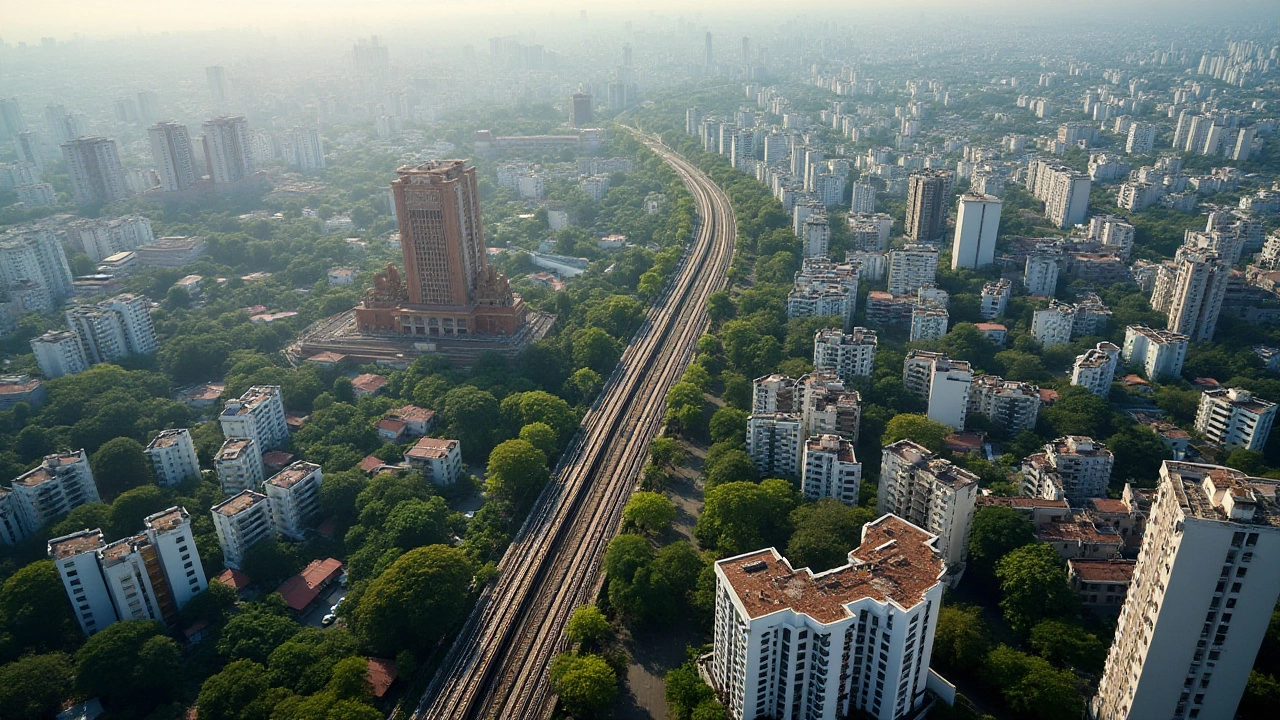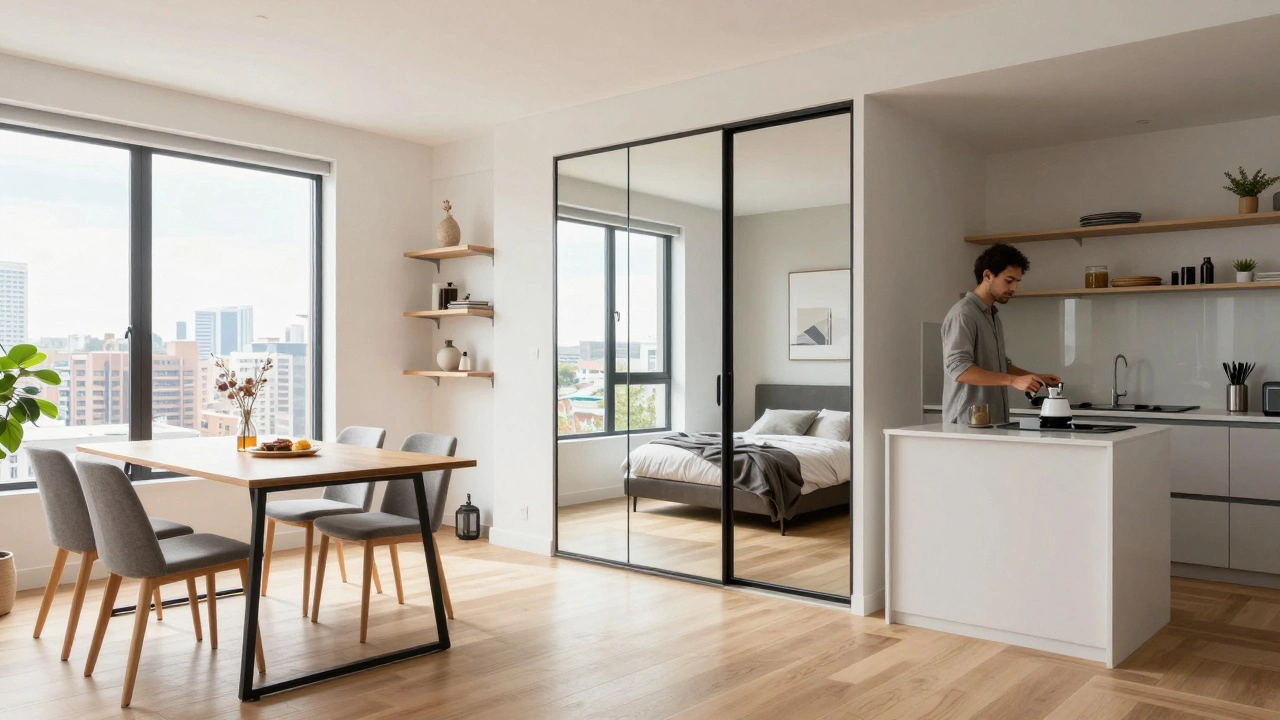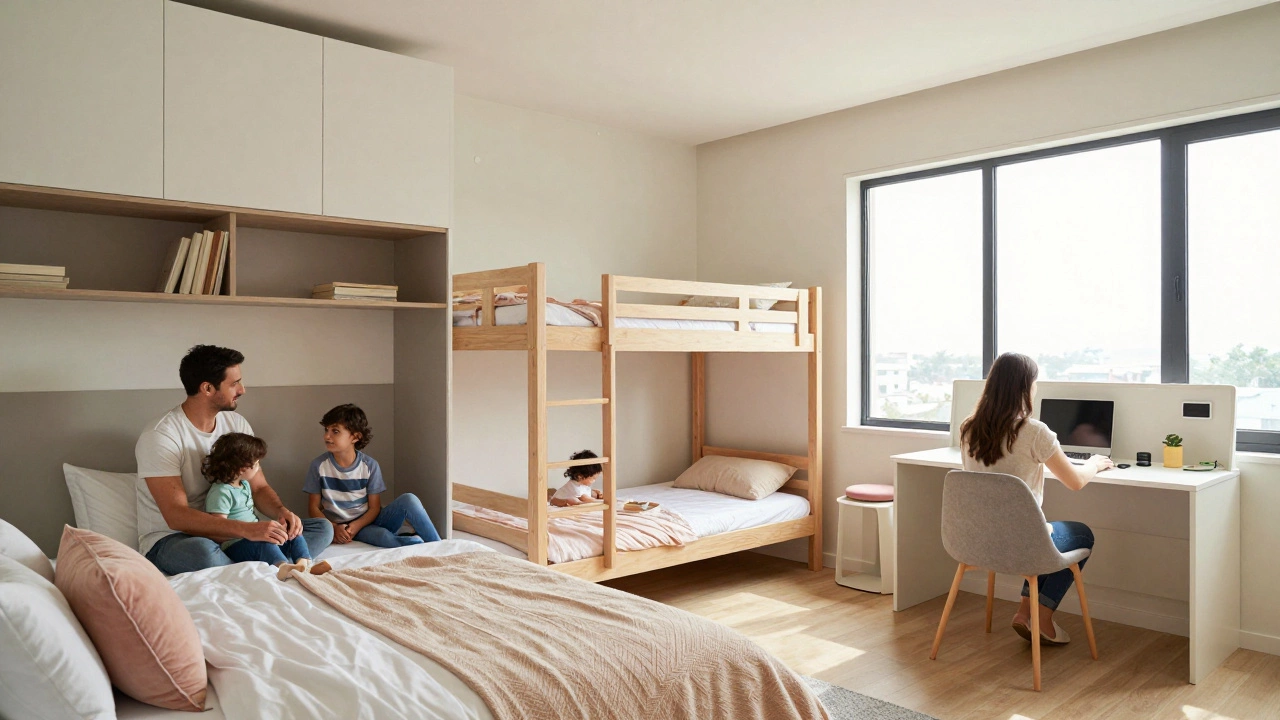In the realm of urban living, the term 'metro' signifies more than just a mode of transport. For city dwellers and potential homeowners, it represents the heartbeat of efficient commuting and connectivity. A property near a metro station often caters to the desire for convenience and rapid transit, shaping lifestyle choices and real estate decisions.
Understanding what defines a metro in real estate terms and grasping its impact on property values can offer a competitive edge in today's dynamic market. As cities expand and transit systems evolve, the allure of metro-adjacent properties continues to heighten, making them a focal point for investors and residents alike.
- Defining Metro in Real Estate
- The Appeal of Metro Proximity
- Factors Influencing Property Value
- Case Studies of Metro Impact
- Tips for Buying Near Metro
- Future of Metros and Real Estate
Defining Metro in Real Estate
The word 'metro' might evoke thoughts of trains rushing underground, or even the sleek stations bustling with commuters. Yet, in the real estate sector, a metro has evolved into much more than a transportation hub. It's a focal point in urban planning that defines the convenience, accessibility, and desirability of a neighborhood. Metropolitan areas are invariably built around a network of these transit lines, dissecting cities into accessible segments where life pulsates with a distinct rhythm. A property near metro often sees heightened interest due to enhanced connectivity, which influences everything from lifestyle choices to property values.
Cities across the globe illuminate the significance of metros in their real estate landscapes. Take, for example, the expansion of the London Underground, famous for being the oldest metro system worldwide. Studies have shown that houses within a half-mile radius of a metro station can attract up to 10% higher prices compared to those further away. The presence of a metro reduces travel time exponentially, subsequently leading to a reduced cost of living, lesser traffic congestion, and far-reaching environmental benefits.
Emphasizing the importance of real estate near metro stations, the American Public Transportation Association points out that in 2018, homes near public transit systems experienced higher value appreciation. This trend indicates that as urban spaces grow denser, the need for efficient transport near residential and commercial properties becomes even more crucial. The appeal lies not only in convenience but in the transformative way metros link disparate areas, forging a unified identity within a sprawling cityscape. This connectivity leads to exponential growth opportunities as businesses cluster around these hubs to tap into the flow of commuters seeking comfort and expedience.
"Metros aren’t just about transport; they’re the backbone of urban development and sustainability," said Nathalie Tocci, a renowned urban planner based in Europe. "They facilitate social inclusion and economic dynamism that sustain the pulse of modern cities."
While considering buying properties near metro stations, it is important to recognize subtle markers that signify sound investments. Observing development trends, zoning laws, and projected transit projects can provide insightful forecasts. A property buyer who aligns these insights with their economic capabilities can secure both a precious living experience and an asset guaranteeing future returns. It's this delicate blend of practicality and vision that makes metro proximity an enduring allure in real estate.
The Appeal of Metro Proximity
The allure of living in close proximity to a metro station is undeniable for many urban residents. One of the most significant draws is undoubtedly the convenience that metro access provides. Imagine cutting down a daily commute that used to take over an hour in rush-hour traffic to just a breezy, 20-minute train journey. This kind of time-saving efficiency not only relieves stress but also enhances quality of life by offering more time for leisure or family activities. Additionally, the reliability of metro systems, which often operate under strict time schedules, allows individuals to plan their day with greater precision, thus fitting into the fast-paced rhythm of city life seamlessly.
Metro proximity also contributes significantly to the increase in property value. Real estate experts have long noted the trend where properties situated near transit hubs experience a rise in demand, which translates to higher market prices. This demand is driven by the social demographics of city dwellers, many of whom prioritize accessibility and connectivity in their housing choices. A study conducted by the American Public Transportation Association (APTA) found that residential areas with metro access performed 42% better in real estate markets than those without. This statistic illustrates the tangible advantages for investors who strategically choose properties near metro lines.
"Proximity to transit services is one of the key factors influencing the desirability and value of urban properties."— Dr. Emily Warren, Urban Studies Expert.For families and individuals, metro stations provide more than just transport solutions; they often act as catalysts for neighborhood development. The emergence of supermarkets, shopping complexes, and entertainment hubs around metro stations turns these areas into thriving communities. The convenience of reaching these amenities without long travels enhances the residential appeal. This ripple effect ensures that investing in property near a metro often yields multifold benefits, setting a stable environment for future value appreciation.
Economic Benefits
Living near a metro station can equate to substantial savings in the long run. People can drastically cut back on time and expenses related to vehicle ownership, maintenance, and expensive gasoline costs. Instead of dealing with the hassles of traffic, parking, and car upkeep, individuals can leverage the metro's reliability and cost-effectiveness to streamline their finances. This economic benefit adds another layer of appeal, particularly for environmentally conscious buyers who are inclined towards minimizing their carbon footprint by reducing dependence on personal vehicles. Furthermore, property near metro stations often see a boost in rental values, making them an attractive option for those looking to invest in rental income.
Sociocultural shifts also play a role in the heightened demand for properties located near metro systems. In today's environmentally aware society, a preference for public transportation aligns with broader global efforts to pursue sustainable urbanization. Making a conscious choice to reside in areas that facilitate reduced car reliance not only supports personal sustainability goals but also contributes towards larger urban sustainability objectives. This symbiotic relationship between metro systems and urban living reflects both practical and ideological pursuits, capturing a significant slice of the modern real estate market.

Factors Influencing Property Value
The proximity of a property to a metro station undeniably plays a significant role in its value, but several nuanced factors further shape these valuations. At the forefront is accessibility, which directly affects desirability for potential occupants. Commuters value quick and easy access to public transportation, reducing travel time and offering more opportunities for leisure and work. A shorter commute means more personal time, which is increasingly sought after as urban life grows more hectic. Moreover, well-connected properties are tempting to companies, often enticing them to set up offices near these transit hubs to draw in a workforce that prioritizes convenience.
Location is another critical aspect, where the blend of residential calm and urban vibrancy counts. Properties located near metro stations often see the benefit of supported amenities like shopping centers, educational institutions, and healthcare facilities. This creates a ripple effect, as enhanced amenities typically lead to increased demand, pushing property prices up. To illustrate, a study by the Real Estate Council shows a 10% appreciation rate for properties within a mile of new metro stations within three years of their opening.
On a strategic front, urban planning and government policies also contribute significantly. Investments in city infrastructure and metro expansion projects can signal upsurges in real estate markets. The anticipation of new or extended lines tends to spark investor interest, leading to price hikes even before completion. Local government incentives and development plans can influence the vibrancy and growth of neighborhoods close to metros, making them ideal for long-term investments.
In terms of economic influence, the influx of businesses that look to capitalize on metro locations transforms these areas into thriving business centers. This economic activity fosters job creation, making such locales attractive to both homebuyers and investors. It's interesting to note the words of famed urban economist, Ed Glaeser:
"Public transit's greatest strength lies in its potential to transform cities into more livable and prosperous environments."
Environmental considerations are also increasingly relevant, as more people are conscious of their ecological footprint. Living near a metro reduces dependence on private vehicles, thereby lowering emissions and promoting a sustainable lifestyle. With climate change discussions at the forefront, properties with strong public transit connectivity are not just seen as valuable, but also more attractive to eco-conscious buyers.
Real estate near metro stations, thus, does more than facilitate commuting; it shapes the tapestry of modern urban life. As demand shifts, influenced by these myriad factors, the relationship between transit and property value continues to evolve, cementing the concept of transit-oriented development as a blueprint for future growth.
Case Studies of Metro Impact
The presence of a metro system has always been a game-changer in the landscape of urban real estate. Its influence on property markets can be profoundly observed with various examples from around the world. Let's delve deeper into these case studies to understand how the definition of a metro translates into significant shifts in real estate dynamics.
One striking example is the transformation witnessed in the areas surrounding the Delhi Metro in India. When the metro connected distant suburbs to the bustling city center, the real estate potential of these outskirts boomed tremendously. The reliance on local buses and private vehicles dropped, creating a more streamlined experience of urban commute. Properties near metro stations saw a dramatic appreciation in value, becoming hotbeds for investment. A study reported that regions within a kilometer from metro stations experienced a price hike of nearly 15% annually, showcasing how vital metro proximity can be for property valuation.
Another compelling case is the impact of London’s Jubilee Line Extension on the Canary Wharf district in the UK. The addition significantly improved accessibility to what was previously an underdeveloped area. This metro enhancement spurred a transformation, turning Canary Wharf into a financial hub. Businesses flocked to the area, and the demand for residential properties skyrocketed. An economic analysis revealed that this metro line added £10 billion to the local economy, underscoring the pivotal role property near metro plays in urban economic growth.
Economic and Social Outcomes
Besides financial growth, metros bring about substantial social benefits. Access to efficient public transport reduces reliance on personal vehicles, easing traffic congestion and lowering carbon footprints. Take the Los Angeles Metro for instance. Since its extension efforts began in the early 2000s, LA has seen a marked decrease in traffic congestion figures, with the daily commuter saving approximately 10 hours of travel time per month. The metro definition here extends beyond transportation; it encompasses an eco-friendly lifestyle shift.
Lessons from Emerging Markets
Emerging markets, where urban development is accelerating, offer fascinating insights into the metro-property relationship. Jakarta, Indonesia, provides a perfect illustration. With the MRT Jakarta initiative, there was a noticeable uplift in urban planning and infrastructure within the city. Developers rapidly took advantage of the new transport lines, resulting in mixed-use real estate projects that abated the city's dense population pressure. Local surveys suggest that more than 70% of the neighborhood residents rely heavily on the MRT, transforming their residential preferences.
The collective experiences from these and many other examples highlight a recurring theme: metros serve as the backbone of modern urban narratives, reshaping real estate landscapes decidedly. Craig Plumb, a notable real estate analyst, once mentioned,
"Metros are not just transit systems; they’re catalysts for evolving how cities grow and breathe, redefining urban life with every new station."These metro-induced transformations make a compelling case for anyone interested in real estate to consider proximity to metro lines as a foundational pointer for property investments.

Tips for Buying Near Metro
Buying a property close to a metro station offers significant advantages, yet it's crucial to weigh various factors before sealing the deal. First and foremost, do a thorough survey of the area and understand the dynamics of the neighborhood. Speak with residents to grasp the vibe and safety aspects of living in that vicinity. The proximity to the metro may enhance convenience, but sometimes it comes with accompanying noise and foot traffic, elements that can affect your living experience significantly. Consider how often metro construction or maintenance could potentially affect your peace and privacy.
Location, as they say, is everything, and this couldn't be more true when contemplating a property near a metro line. Pay attention to future development plans in the area; sometimes a locality that seems quiet today may undergo marked transformations, bringing in more people and development. This can be a double-edged sword, sometimes enhancing property value, or at other times leading to overcrowding. The choice will often depend on what kind of lifestyle shifts you're willing to accommodate. "Living near a metro can mean more than just convenience," remarks urban development expert John Lambert, "it effectively ties you to the heartbeat of city growth, for better or worse."
Accessibility isn't just about the distance to the station, but also about the ease of incorporation of the location into your lifestyle. Assess the connections between the property and other parts of the transit network. Offering multiple transit lines could provide you more routes and options, affecting your mobility positively. Imagine a property naturally aligned with major lines that reduce transfer times and provide direct paths to your most-visited locations. Pay attention to important routes, particularly those that make your daily commute efficient or connect to major city hubs.
Another critical factor is the amenities available in the neighborhood surrounding the property near metro. Are there reliable grocery stores, well-reviewed restaurants, and recreational spots within walking distance? The value of local amenities can sometimes override the slight inconvenience of not being right next to the metro. Schools, parks, and healthcare facilities are important considerations for families. The presence and quality of these amenities can also impact resale value, marking the area as desirable not only for you but eventually for future buyers as well.
Lastly, assess the financial implications carefully. Being near a metro station often commands a premium price, not just initially, but also in terms of property taxes, which could be on the higher side due to increased demand and perceived value. Evaluate whether the convenience and potential appreciation in property value justify the price difference. Keep an eye on shifts in real estate trends to avoid paying more than you should. Consider consulting with a real estate expert who specializes in urban properties. They can provide better insights into market trends and help you make informed decisions.
Future of Metros and Real Estate
As urban landscapes continue to evolve, the integration of metro systems with the real estate sector becomes increasingly pivotal. Cities worldwide are consistently expanding their metro networks to meet the growing demand for efficient transit solutions. This expansion is reshaping urban living, directly impacting the real estate market. One of the most notable effects is the rising interest in property near metro stations. These areas are often seen as high-potential investment zones due to the convenience and connectivity they offer. With increasing urbanization, the focus on metro-oriented development is expected to grow, influencing both commercial and residential property trends significantly.
According to urban planners, future metro developments will prioritize sustainable growth and smart technology integration. This implies that properties situated close to metros will not only offer superior accessibility but will also be associated with green spaces and innovative infrastructure. The value of these real estate assets is promising to rise, making them lucrative investments in the long term. As more people gravitate towards eco-friendly living environments, the demand for metro-adjacent housing is set to increase. This demand is fueled by the younger generation that prioritizes time-saving commuting options and environmentally conscious choices.
A recent report from the Urban Land Institute highlights, 'The effective integration of metro networks with urban planning catalyzes economic growth, enhances urban livability, and contributes significantly to sustainable development goals.'These insights affirm that as metro networks evolve, they are likely to redefine residential and commercial zoning. Future metro extensions not only aim to cover broader geographical areas but also incorporate advanced technology for efficient operations. This technological evolution will likely introduce features such as smart ticketing and real-time updating systems, further elevating the desirability of areas close to these systems.
For investors and potential homeowners, the key lies in identifying upcoming metro projects and understanding their potential impact on nearby properties. By doing so, one can strategically position themselves in the market to leverage future appreciation. As cities adopt more robust urban policies that integrate metro expansions, the correlation between metro proximity and property value stands to strengthen. With technology-driven enhancements on the horizon, metro systems promise to offer seamless and enriched commuting experiences, bolstering the attractiveness of adjacent neighborhoods as prime real estate hubs.





